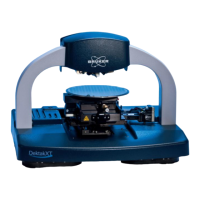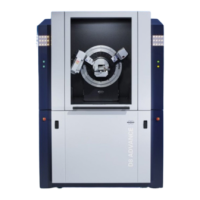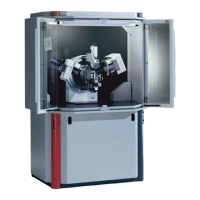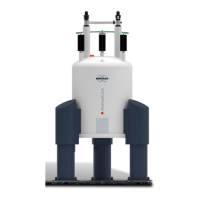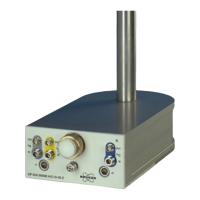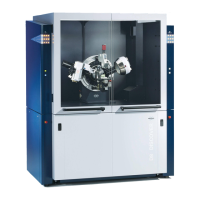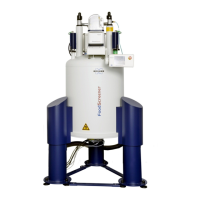D2 PHASER User Manual
DOC-M88-EXX141 V5 – 01.2015 15
Alignment of the diffractometer
Introduction
Normally it is not necessary to align the D2 PHASER goniometer. The D2 PHASER is factory aligned
and stable. Alignments, like the zero-point of 0D-detectors, the horizontal position of the sample
surface, the 1D-detector calibration and the linear-to- goniometer calibration, can only be done at the
Bruker AXS factory or by service, by means of special equipment.
The basic components of a diffractometer system with standard configuration are shown in fig. 9 and
10 schematically. The main component is the goniometer with a
--geometry. The --geometry
holds the sample horizontally and sets the detector and tube to
-position each, simultaneously (fig.
12).
The orientation of the sample surface remains fixed. The tube is mounted precisely so that the position
of the focus is on the measuring circle ((d) in fig. 9 & 10) with 141,4 mm radius. The connection of the
line from the tube focus to the goniometer centre defines the primary beam direction. The goniometer
centre is defined as the common rotation axis of primary and secondary angular arms, i.e. of the tube
and the detector respectively.
The beam divergence on the primary part (fig. 10) is set by the divergence slit module (g) which is
manually exchangeable. The position of the detector slit module (l) defines the position where the
diffracted X-ray beam is detected with 0D-detectors (k) on the secondary part of the system (fig. 10).
This detector slit module (l) is also manually exchangeable.
The antiscatter slit (n) defines the divergence angle range on the secondary part which is detected by
the detector (k). The divergence and antiscatter slits must fit together and are aligned to the
goniometer centre (with a special tool set of Bruker AXS). The antiscatter slit (n) is also manually
exchangeable.
In the following, each system which is limiting or shaping X-ray radiation, is called an X-ray optical
system or X-ray optics. The optical systems which are used for the D2 PHASER may be slit modules,
absorber modules and filter modules but no monochromators or other crystals.
Optical components which are conditioning the beam which is emitted by the tube are called primary
X-ray optics, e.g. (g). Components which lead and condition the diffracted radiation beam from the
sample to the detector are called secondary X-ray optics, like (n) and (l).
The sequence of the beam path from source to detector is as following: X-ray source (f), primary X-ray
optics (g), sample in goniometer centre (a), secondary X-ray optics (n), (l) and detector (k). The glass
slit is a tool for the reference determination.
Philosophy of alignment for D2 PHASER systems
1.) 0D-detectors (NaI scintillation counter and XFlash detector):
a. The primary divergence slit system is factory aligned and can only be realigned by Bruker AXS
personnel with a special tool set.
b. The secondary divergence slit system is also factory aligned and can only be realigned by Bruker
AXS personnel with a special tool set.
c. The rotation sample holder and sample changer are factory aligned. The sample surface is parallel
to the connection of the two rotation axes on the horizontal sliders and can only be realigned by
Bruker AXS personnel with a special tool set.
2.) 1D-LYNXEYE detector:
a. The primary divergence slit system is factory aligned and can only be realigned by Bruker AXS
personnel with special tool set.
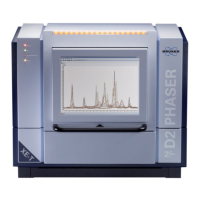
